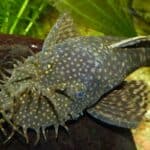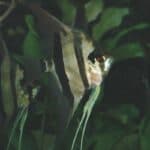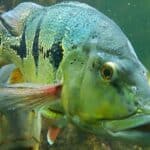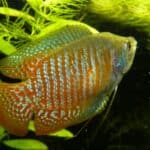If you’re looking for a new and exciting addition to your aquarium, consider Bleeding Heart Tetra! These little fish are incredibly hardy, capable of thriving in less-than-ideal water conditions. They’re also quite attractive, which is sure to add some visual interest to your aquarium.
The most distinctive feature of Bleeding Heart Tetras is the red dot, or “heart”, located on their sides. This gives them their common name and is what makes them so unique and desirable.
But what do you really know about the Bleeding Heart Tetra? Here are some fascinating facts about Bleeding Heart Tetras, including how to care for them and what to expect.
Species Summary

The Bleeding Heart Tetra (Hyphessobrycon erythrostigma) is a species of tropical freshwater tetra belonging to the Characidae family. These tetras are found in South America, in the upper Amazon River basin near the three borders (Brazil, Peru, and Colombia).
The species are found in slow-flowing streams and flooded forest areas. They’re usually found near vegetation, dry leaves, roots, and driftwood in dark waters that are rich in tannins.
These fish are relatively small, making them ideal for most aquariums. And, when kept in a large shoal, they exhibit some amazing behaviors that are sure to impress any onlookers.
Bleeding Heart Tetra Care Guide
They are relatively easy to care for, but there are a few things to keep in mind in order to keep them healthy and happy.
Tank Size
Although they don’t grow very large, Bleeding Heart Tetras must be kept in a school of at least six fish, so you’ll need an aquarium that can accommodate a small group. A good rule of thumb is to have an aquarium that is at least 21 gallons, with dimensions starting at 31″ x 11″ x 15″.
This will give your Bleeding Heart Tetras the space they need to school and thrive. Remember, the more space you can provide, your fish will be better off.
Tank Mates
When it comes to choosing the right tankmates for your Bleeding Heart Tetra, there are some considerations.
First, these fish are peaceful by nature and get along well with other fish. Second, they are relatively small, so you’ll want to avoid aggressive or larger fish that could injure them. Finally, they are known to eat smaller fish, so anything that fits in their mouths could become food.
With all of that in mind, here are some potential Bleeding Heart Tetra tankmates to consider:
● Corydoras
● Tiger Pleco
● Cardinals
● Swordtails
Same Species Tanks
The Bleeding Heart Tetra is often kept as a single species in large aquariums, planted tanks, or biotope-type aquariums.
Although they’re often kept as solitary fish, Bleeding Heart Tetras do best in groups of six. Not only will a group of these fish provide endless hours of entertainment as they swim and play together, but they’ll also help keep your Bleeding Heart Tetra healthy and stress-free.
Water Parameters
These fish are incredibly resistant and can tolerate a wide range of water parameters. However, they are susceptible to pollutants in the water and the accumulation of organic matter in the tank.
The perfect temperature for keeping Bleeding Heart Tetras in an aquarium is 75 to 82 degrees Fahrenheit. The ideal pH range is between 4.0 and 7.2, and hardness is 18 – 215 ppm.
What to Put in Their Tank
As with any other aquatic animal, Bleeding Heart Tetras need an aquarium heater and a filtering system. The filtration system should be well-sized and create a low flow. These fish don’t like bright lights, so keep the lighting low or use floating plants as cover.
What’s more, it’s important to provide Bleeding Heart Tetras with a tank that mimics their natural habitat as closely as possible. This means a tank with a sandy substrate, driftwood, and a bed of dry leaves. A densely planted aquarium will also be appreciated.
It’s also beneficial to leave plenty of open space for Bleeding Heart Tetras to swim freely. A dark substrate will help bring out their colors.
Common Diseases
They are very resistant to diseases and can even tolerate less-than-ideal water conditions. However, like all tetras, they are susceptible to Ich and other diseases if they are stressed.
The best way to prevent your Bleeding Heart Tetra from getting sick is to keep the water quality in their tank high. A good diet and regular water changes will also help to keep your fish healthy.
And remember: Quarantine new fish before adding them to your Bleeding Heart Tetra’s tank to prevent the spread of disease.
Food and Diet
The Bleeding Heart Tetra is an omnivorous fish, and in the wild, its diet consists of a variety of foods, including worms, crustaceans, and insects. Secondarily they eat plant matter. Its consumption will depend on the availability of food in the natural habitat.
Bleeding Heart Tetras are not picky eaters in an aquarium and will accept most types of food. A good diet for these fish includes high-quality commercial fish food as well as live, fresh, or frozen foods such as bloodworms, brine shrimp, or daphnia.
It’s important to feed your Bleeding Heart Tetras several times a day, as they are always hungry! A varied and balanced diet is essential for these fish to reach their full potential.
Lifespan
While they are not the longest-lived fish species, with a lifespan of 5-6 years in captivity, bleeding heart tetras can provide years of enjoyment for their owners.
In the wild, Bleeding Heart Tetras don’t usually live as long as their captive cousins. That’s because they’re more prone to diseases, attacks from other animals, and environmental causes.
If you want your Bleeding Heart Tetra to have the best chance at a long and healthy life, give them a good home in a well-maintained aquarium with stable water parameters.
Appearance
It has a flat, tetragonal body with a broad dorsal fin and a tiny fatty fin. The body of the fish is pink to red, with a transparent pinkish tone and a pink line going along the body’s middle. The fish also has a black mark on the top of the dorsal fin.
But the most striking feature of the Bleeding Heart Tetra is the distinct red heart mark in the middle part of the fish, on both sides. This mark is what gives the fish its name.
Size
With proper care, these fish can quickly grow to 3 inches in length, though they are usually around 1.9 inches in the wild.
Behavior and Temperament
This is a tropical fish species that is known for its peaceful behavior. It can be kept in a community aquarium with other fish of the same size and behavior.
The Bleeding Heart Tetra is a very active animal, occupying practically all strata of the tank. However, they prefer to feed on the surface or in the middle part of the tank. Even though they are not the most active tetras, a school of these fish has a unique beauty and behavior.
These fish are more natural when kept in a group of at least six individuals. If you keep them in pairs or trios, there may be severe persecution of the weakest of the group. Their behavior can change if they don’t feel comfortable in the tank – hidden among vegetation, rocks, and driftwood.
Although they are not necessarily aggressive towards other fish species, male Tetras can behave aggressively towards each other or similar fish. Occasionally they may nibble on long-finned or slow-swimming fish.
Breeding
The Bleeding Heart Tetra is an oviparous species, which means that the female freely dumps the eggs in the middle (egg-scattering species). In nature, its reproductive period follows the rhythm of floods, with the change in water chemistry being one of the main factors triggering the reproductive process.
The male will lead the female to release the eggs freely, which will then be fertilized by him; most of the eggs will go to the bottom of the aquarium or stay in the middle of a cluster of plants. The eggs will hatch in up to three days, and larvae will be swimming freely for up to 48 hours. The parents then abandon the eggs.
In addition, they prefer to breed in acidic waters. They are generally bred in breeding tanks, with something at the bottom – like a mesh – preventing the parents from eating the eggs until they are removed to another location. The fingerlings are tiny; they must be fed with paramecium or another type of infusoria until they are big enough to accept other foods.
Gender Differences: Male vs Female
There are some pretty big differences between the sexes. For one, males have much longer and more pronounced dorsal and anal fins. Females, on the other hand, have shorter and rounder fins. As for body shape, males are typically straight while females are plumper.
These differences can be pretty easily seen when you put a male and female side by side.
Bleeding Heart Tetra Fun Facts
● The interaction between rival males is fascinating, and their coloration is enhanced when they vie for the attention of females.
● Its biotope is so full of acids originating from the organic matter of the forest that the salt content is close to zero.
● A viral tetra species in the aquarium, due to its rusticity and beauty, it can be easily confused with other “blood tetras” such as H. socolofi and H. pyrronhotus. All have a reddish humeral spot.
References.
ASAP, Aquarium Science Association of the Philippines, 1996. Aquarium species in the Philippines. ASAP Aquarist Database Report. 9 p. Quezon City, Philippines.
Hardy, J.D., 1993. NODC taxonomic code links biology and computerized data processing. Earth System Monitor 4(2):1-2.
Mills, D. and G. Vevers, 1989. The Tetra encyclopedia of freshwater tropical aquarium fishes. Tetra Press, New Jersey. 208 p.
Ortega, H. and R.P. Vari, 1986. Annotated checklist of the freshwater fishes of Peru. Smithson. Contrib. Zool. (437):1-25.








